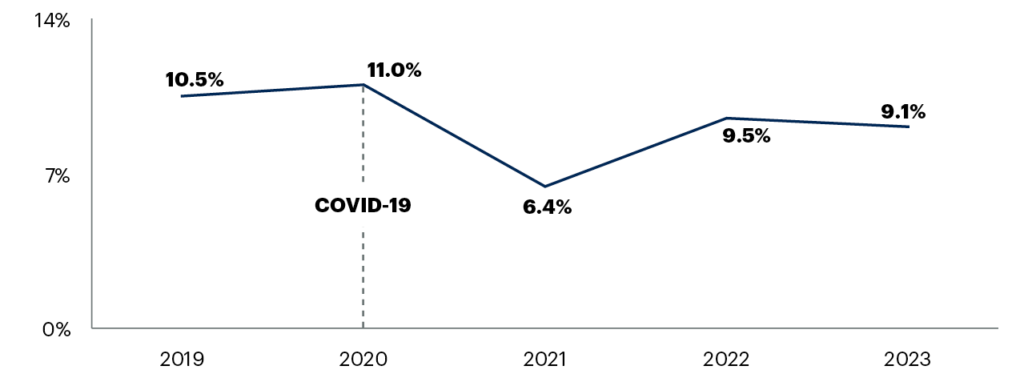A Gartner survey of 410 CMOs and marketing leaders noted that 71% blame a lack of the budget to fully execute their strategy in 2023. The survey revealed that marketing budgets compose 9.1% of total company revenue in 2023, remaining relatively flat but still dipping slightly from the 9.5% reported in 2022 (see Figure 1).
“Suppressed budgets, increasing costs and lower productivity are squeezing CMOs’ spending power,” said Ewan McIntyre, chief of research and VP Analyst in the Gartner Marketing practice. “As volatility becomes the new normal, many CMOs are pricing disruption into their 2023 plans.”
Figure 1. 2023 Marketing budget as a per cent of total revenue (2019-2023)

The survey also noted that 75% of CMOs are facing increased pressure to “do more with less” to deliver profitable growth in 2023. Because of this, 86% of marketers said they must make significant changes to how the marketing function works to achieve sustainable results.
“In 2023, CMOs need to become a new type of enterprise leader. This goes beyond serving at the helm of the brand but also assuming a more business-focused role that pivots into a period of investing for profitability versus growth. Those that carry on status-quo will face significant challenges in the near-term,” said McIntyre.
Under pressure to cut technology spend
CMOs have seen technology investments tumble into new lows of unproductivity, with utilisation rates falling from 58% in 2020 to 42% in 2022, according to Gartner research. For this reason, 75% of marketers report being under pressure to cut martech spending this year to deliver better ROI. However, the highest reported investment increase across all major marketing resources by CMOs this year goes toward marketing technology, while the largest decrease is to labour.
McIntyre opined that like gamblers looking to write off their losses with the next bet, CMOs are attracted to the allure of newer technologies, no doubt amplified by the chatter around generative AI.
“They are hungry to see its potential to transform marketing campaigns and content creation. While this hunger to invest is understandable, it illustrates the sunk-cost fallacy that more tech is always better,” he added.

“The willingness to let the majority of their martech stack sit idle signifies a fundamental resource disconnect for CMOs. It’s difficult to imagine them leaving the same millions of dollars on the table for agencies or in-house resources. This trade-off of technology over people will not help marketing leaders accelerate out of the challenges a recession will bring.”
Ewan McIntyre
Increase social ad spend and decrease search
Paid media leads in budget allocation across major marketing resources (25.6% of overall 2023 budget), followed by marketing technology (25.4%), labour (24.6%) and agencies (23.3%).
Social advertising, which currently takes up the most paid media budget, was identified as the top digital channel to receive increased investment this year, followed by digital video advertising and influencer marketing. Search advertising was identified by most respondents to receive decreased investment in 2023 (see Figure 2).
Figure 2. Change in investments for digital channels in 2023 (percentage of respondents)

More than wishful thinking in a disruptive environment
McIntyre said growth, yield and return must be foremost in CMOs’ minds as they go beyond standard prioritisation. CMOs should double down on scenario planning and balance efficient near-term execution with investments that enable them to build future-forward capabilities.





